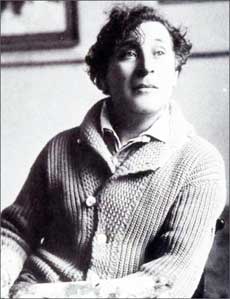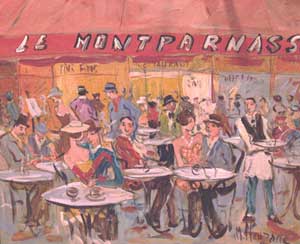"I aspired to see with my own eyes what I had heard of from so far away: this revolution of the eye, this rotation of colours...that could not be seen in my town. The sun of Art then shone only on Paris."
No one has put it better than artist Marc Chagall when trying to sum up the feeling in Montparnasse during les Années Folles (the Crazy Years). It was the golden age of the 1920s.
As Europe came alive again after the Great War, people were drawn to the City of Light like a flame.

Scores of writers fled suffocatingly conservative Anglo-Saxon cultures in search of the intellectual, artistic and sexual freedom that only the French capital could offer. Montparnasse became a center and focus of creativity, with its lovely cafés, bohemian bars and studios.
The romantic, artistic Paris of Zola, Manet, Degas and Fauré in Montmartre was a world away economically, socially, and politically from the gritty, tough-talking, uncompromising, emigrant artists that inhabited in Montparnasse.
The intellectual life in Montparnasse was not peaceful, but rather accented by quarrels between artists about art and artistic currents, ideological debates about literary and theatre styles. Writers like Gide and Valéry were at the vanguard of French literature and political thoughts. On the other hand Hemingway, James Joyce writers at the forefront of French thought, while aspiring international writers such as Ernest Hemingway, F. Scott Fitzgerald and James Joyce converged in Montparnasse, looking to find inspiration in the Parisian setting.
Paris was transformed into the home of avant-garde with the advent of Cubism, Surrealism and Dadaism - Picasso and Matisse were the poster-boys for a scene that included the genius of Chagall, Giacometti, Miró and Calder. Montparnasse became one of the most prosperous and prolific art colonies of the 20th century.
And the cafés were the key to it all. That's were the magic occurred.

Imagine the scene: a focused young man wearing a creased jacket is sitting at the table in the corner of the cafe. He has been scribbling furiously in a notebook all afternoon and has finally fallen asleep, his head resting on the table, lulled by the conversation and warmth of the cafe.
The year is 1924 and that young man could be Ernest Hemingway finishing The Sun Also Rises, or James Joyce writing Finnegans Wake.
The cafés and bars of Montparnasse were where the creative genius of the 20th century hung out. The cafés at the heart of Montparnasse's night-life were in the Carrefour Vavin, which is now called the Place Pablo-Picasso.
In the neighborhood's zenith, cafés like Le Dôme and La Closerie and others such as des Lilas, La Coupole — all of which are still in business— were a lifeline to the starving artists that populated Montparnasse. Jean Cocteau once said poverty was a luxury in Montparnasse.
Living in an unheated studio with no running water that was infested with rats was almost a badge of honor. In the precious cafes of Montparnasse, an impoverished artist was allowed to occupy a table all evening for only a few centimes. The proprietor of La Rotonde, Victor Libion, told the waiters not to wake them if they fell asleep and would look the other way when they broke ends of the baguettes in the bread baskets.
Libion was even known to accept a drawing as payment if the artist couldn't pay the bill and the sketches were held until the bill was paid and as such, there were times when the café's walls were littered with a collection of artworks that today would make the curators of the world's greatest museums drool with envy.